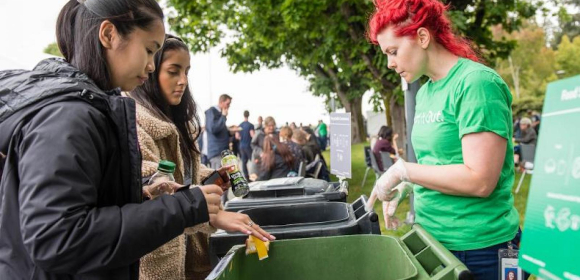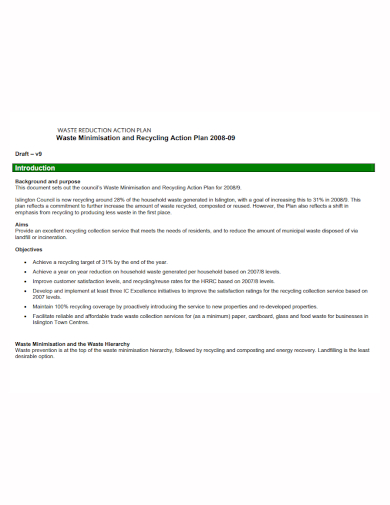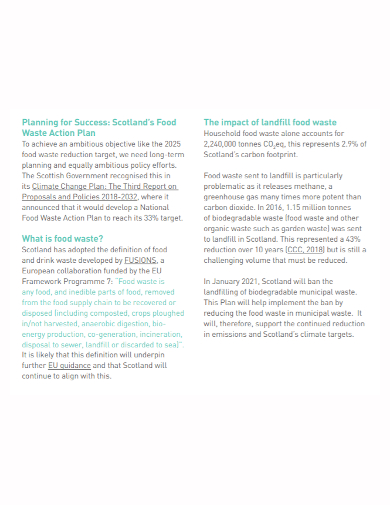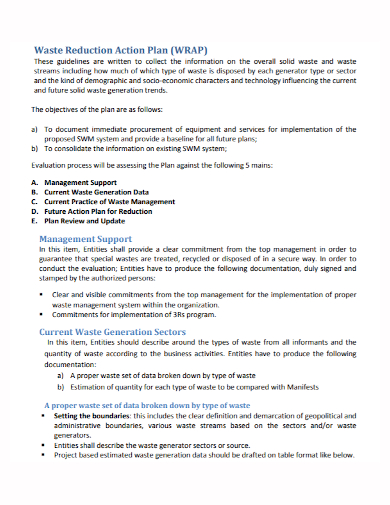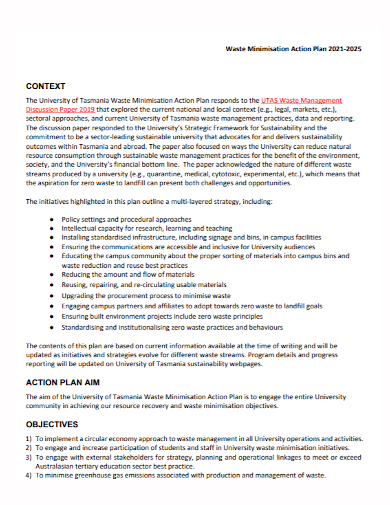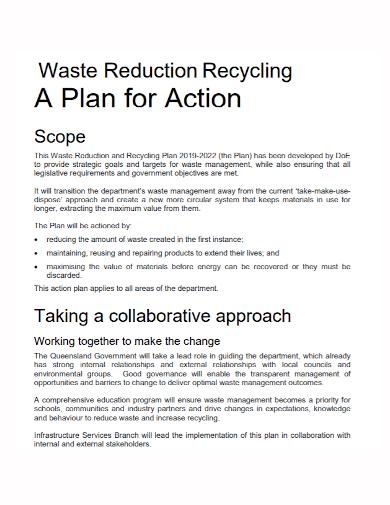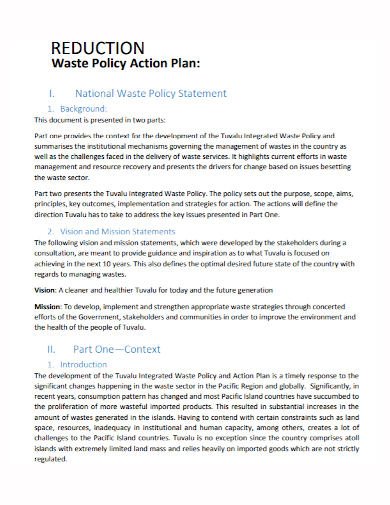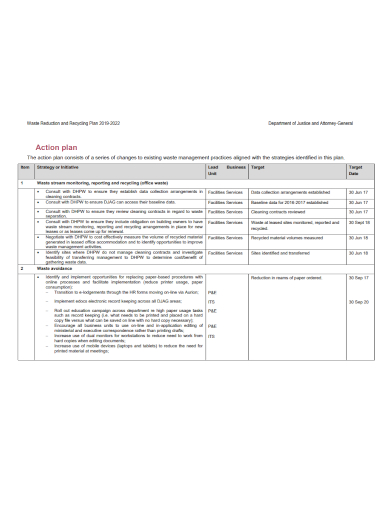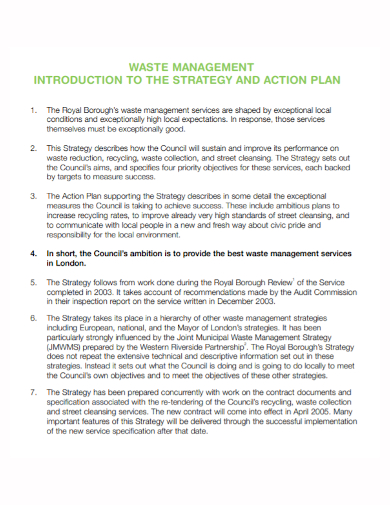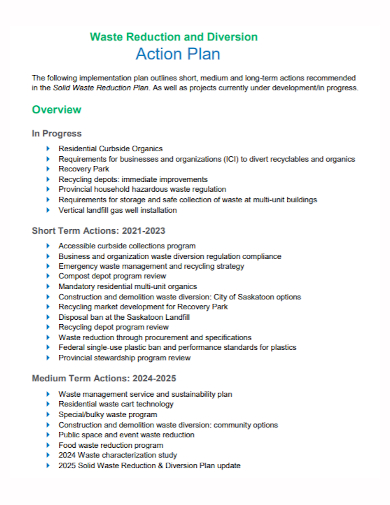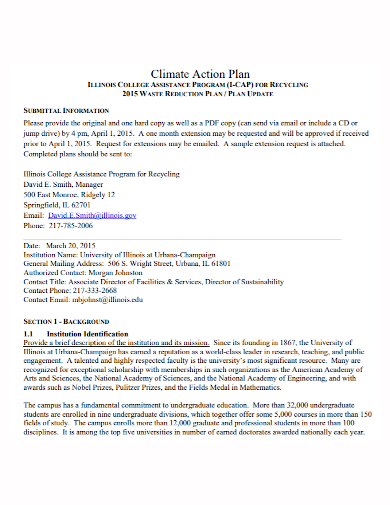10+ Waste Reduction Action Plan Samples
The method of preventing waste by reducing or eliminating the amount of resources initially utilized is known as waste reduction or source reduction. One of the most compelling reasons to decrease trash is to save space in existing landfills and avoid the need to construct new landfills, which squander precious land and pollute the air and water. We are also preserving resources by decreasing our garbage. To ensure the success of waste reduction, you need a plan of action. Need some help with this? You’ve come to the right place! In this article, we provide you with free and ready-made samples of Waste Reduction Action Plans in PDF and DOC format that you could use to better the environment. Keep on reading to find out more!
1. Waste Reduction Action Plan Template
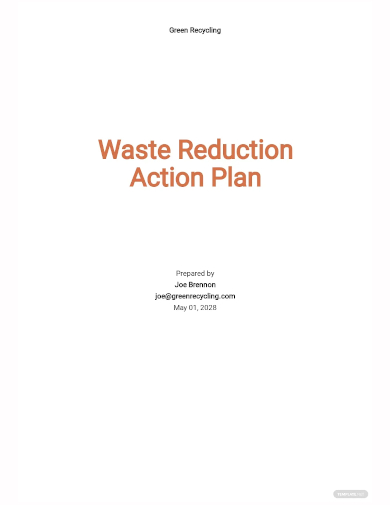
2. Waste Minimisation Reduction Action Plan
3. Food Waste Reduction Action Plan
4. Waste Reduction Management Action Plan
5. Sample Waste Reduction Action Plan
6. Waste Reduction Recycling Action Plan
7. Waste Policy Reduction Action Plan
8. Standard Waste Reduction Action Plan
9. Waste Reduction Strategy Action Plan
10. Waste Reduction and Diversion Action Plan
11. Waste Reduction Climate Action Plan
What Is a Waste Reduction Action Plan?
A solid waste management strategy is vital for your company or organization because it may help you reduce operating expenses and improve overall efficiency. Furthermore, you may be able to improve the environmental reputation of your company. Creating a waste reduction strategy allows you to rethink procedures in order to produce less waste and boost efficiency. It’s also an opportunity to renegotiate contracts with suppliers and subcontractors to have them return or minimize garbage that you’re now paying to dispose of.
How to Make a Waste Reduction Plan
You may construct an action plan once you’ve completed a waste audit and set a waste policy. Begin with low-cost, simple-to-implement waste reduction strategies. A Waste Reduction Plan Template can help provide you with the framework you need to ensure that you have a well-prepared and robust plan on hand. To do so, you can choose one of our excellent templates listed above. If you want to write it yourself, follow these steps below to guide you:
1. Keep an eye on your waste stream and collect statistics.
Begin by doing a trash audit to establish the types of waste you produce. You may either do a waste audit on your own or hire a waste management consultant to assist you. If you’re doing the audit on your own, make sure your data is as precise and full as possible so you can concentrate your efforts on the most serious issues.
2. Set your team’s achievable goals.
Now that you have the information, consider how you might improve. Create a strategy with your team to uncover answers and a plan to put them into action. Make sure your objectives are explicit and quantifiable so you can track your progress. Assign someone on your team to oversee your waste management strategy and urge everyone to contribute to accomplish your objectives.
3. Make a waste management plan.
Determine the most effective techniques for dealing with each of your waste sources. Implement a daily routine and allocate duties to personnel to keep your strategy on track.
4. Make a plan to deal with hazardous trash.
Hazardous materials are not permitted in your dumpster and are not recyclable. Oils, paints, batteries, and medical waste all require particular disposal since they are potentially poisonous, combustible, or hazardous to persons and the environment.
FAQ
What exactly is waste reduction, and why is it so crucial?
Waste reduction occurs via effective use of material resources, which lowers raw material consumption, lowers prices, and minimizes pollution.
Why should we cut back with waste?
One of the most compelling reasons to decrease trash is to save space in existing landfills and avoid the need to construct new landfills, which squander precious land and pollute the air and water.
What are the environmental benefits of minimizing waste?
Reduced waste means less rubbish ends up in landfills, which is good for the environment. Natural resources are used less. CO2 emissions are reduced.
Overall, a strategy may assist your organization in being more efficient, avoiding fines, saving money, remaining ethical, and bringing your staff together to achieve a single objective. To help you get started, download our easily customizable and comprehensive samples of Waste Reduction Action Plan today!
Related Posts
FREE 13+ Compliance Checklist Samples
FREE 12+ Distribution Plan Samples
FREE 11+ Production Plan Templates
FREE 10+ Subcontractor Safety Management Plan Samples
FREE 10+ Child Care Risk Management Plan Samples
FREE 10+ Environment Protection Policy Samples
FREE 10+ Post Implementation Review Samples
FREE 10+ Post Implementation Review Samples
FREE 8+ Housekeeping Inspection Checklist Samples
FREE 15+ Asset Management Plan Samples
FREE 12+ Healthcare Marketing Plan Samples
FREE 10+ Customer Implementation Samples
FREE 10+ Sample Construction Risk Assessment
FREE 10+ Client Onboarding Checklist Samples
FREE 10+ Housekeeping Checklist Samples
